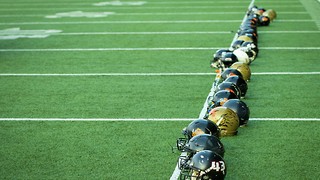A Musing on the Pantsuits of McAfee Westbrook
In light of the new season of The Politician, Archie Hamerton reflects on the relevance of the dazzling pantsuits: its social significance and historical legacy.
As the second series of Ryan Murphy’s cutthroat and seductive comedy The Politician drops, there is something specifically apolitical drawing my attention: the costumes. This season has graduated from the high school playground of California, to the hyper wealthy generational battlefield of New York state politics, the permeable wealth and privilege of the precocious characters smacking of Murphy’s opulent, outlandish camp. Their wealth manifests in lavish costuming, from Alice’s pearls and pastel twin sets evoking Jackie Kennedy, to Georgina’s C.Z.-Guest-style pool side glamour; the show’s outfits are rooted in American privilege and political iconography. The eponymous politician of the show, Payton, seemingly sports a reptilian second skin, in the protective coverage of his turtlenecks. But less overtly symbolic, and yet still just a fun is the standout style of the show: the fashion of Payton’s classmate and campaign advisor, McAfee Westbrook, played by Laura Dreyfuss.
McAfee’s style consists of oversized pant suits, double breasted blazers with flared pants; worn over a t-shirt as opposed to a more formal blouse, and paired large aviator shades and sneakers. It is coolly precise, toeing the line between smart-casual, and would seem fitting in the seventies, eighties, or exist quite happily now, whenever fashion commands a sort of unapologetic modernity. Even her name, McAfee, with its ambiguity of fore-or-surname seems like a means of fashioning herself as a figure of easy formality, in the presidential tradition of being known by surname: Senator McAfee wouldn’t sound entirely unrealistic. Running Payton’s campaign from her phone, looking up through her statement shades with a resigned stare, we see she is defined by both political ambition, and indeed style—after hiring her, even Bette Midler’s Hadassah gleefully states, ‘I like your personal style’. This personal style is courtesy of Lou Eyrich, Murphy’s go-to costume designer, who has kit the casts of Hollywood, AHS, Feud, and Pose alike in a wardrobe of the strikingly glamorous, yet campily accessible.
"A striking power suit: another playfully cutthroat figure"
McAfee is no exception: the boxy pink dad suit she wears in the first episode is no high fashion couture, but available on Asos, making her an emblem of easy commercial self-expression (even if that is somewhat coupled by a slightly distasteful partiality for fast fashion.) The pink suit is followed by a neon green one, then a pastel blue, then a red and ochre seventies pattern, and so on: this succession of brightly coloured boxy power suits, always styled with sneakers and enormous aviators, leads Hadassah to deem her quite rightly ‘a sherbet Diane Keaton’. It recalls too the silhouette of Jodie Comer’s favourite Villanelle costume, a striking power suit: another playfully cutthroat figure.
Along with Keaton, another comparison to a seventies legend levelled at McAfee is ‘The girl with the big Gloria Steinem glasses’, a fitting thematic parallel, as her political stoicism—and indeed centre parted hair and enormous glasses—seem to live up to Steinem’s own second wave ideologies, back in the spotlight again thanks to another fantastic show, Mrs. America.
The boxy blazered teenage machiavels in their high school-cum-gladiatorial arena also speaks to Heathers, the eighties cult film that Murphy often references in his work; McAfee then also is in the spirit of the eighties, her power suit a testament to the ‘doing it in heels, women in the work place’ thinking. But the eighties political power suit has survived Thatcher—her almost Dracula silhouette of pointed shoulder pads is replaced with McAfee’s slightly childlike boxiness, her suits stubbornly baggy. They have survived even Clinton, a modern patron of the pantsuit (though with the current excitement around Sittenfeld’s Rodham, a speculative fiction imagining if Hillary hadn’t married Bill, one wonders if McAfee has a little of a younger Clinton in her too.) She casually harvests bits from all these sources, to create a relaxed silhouette worthy of Katharine Hepburn, paired with Comme Des Garcons converse.
"Stylish, fun, and yet slightly upsetting"
Forever brightly coloured in pops or pastels, there is no attempt at traditional masculinity or political seriousness—her suits are never dower and monochrome, never partnered with a shirt and tie—but likewise there is no trying for a feminine figure in her suits. She rejects the fitted pencil-skirts in favour of flares; renounces the fitted pant suits of AOC (who is surely omnipresent, what with the second series’ central theme of young progressives breaking into local New York politics.) Instead there is a careless androgyny to her costume—stylish, fun, and yet slightly upsetting, in the implication that women must reject sexuality and become sort of political androgyne to have a career in governance, a thematic plot point in the second season. The baggy casualness speaks to her apathetic dry wit; but the timeless formality of the suit, evokes a new kind of Machiavellian ambition: one in neon green flares, the summation of the juvenile ruthlessness that fuels the show’s central characters.
 Comment / Plastic pubs: the problem with Cambridge alehouses 5 January 2026
Comment / Plastic pubs: the problem with Cambridge alehouses 5 January 2026 News / Cambridge academics stand out in King’s 2026 Honours List2 January 2026
News / Cambridge academics stand out in King’s 2026 Honours List2 January 2026 News / Cambridge businesses concerned infrastructure delays will hurt growth5 January 2026
News / Cambridge businesses concerned infrastructure delays will hurt growth5 January 2026 News / AstraZeneca sues for £32 million over faulty construction at Cambridge Campus31 December 2025
News / AstraZeneca sues for £32 million over faulty construction at Cambridge Campus31 December 2025 Interviews / You don’t need to peak at Cambridge, says Robin Harding31 December 2025
Interviews / You don’t need to peak at Cambridge, says Robin Harding31 December 2025








